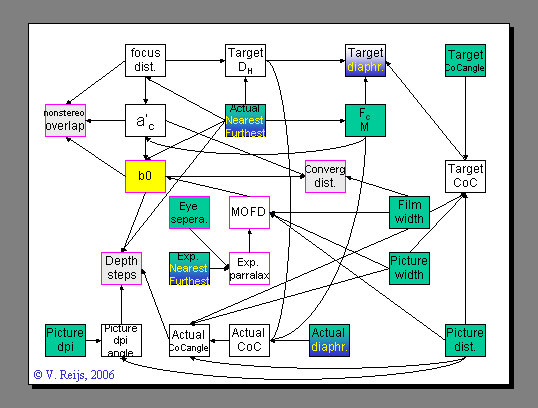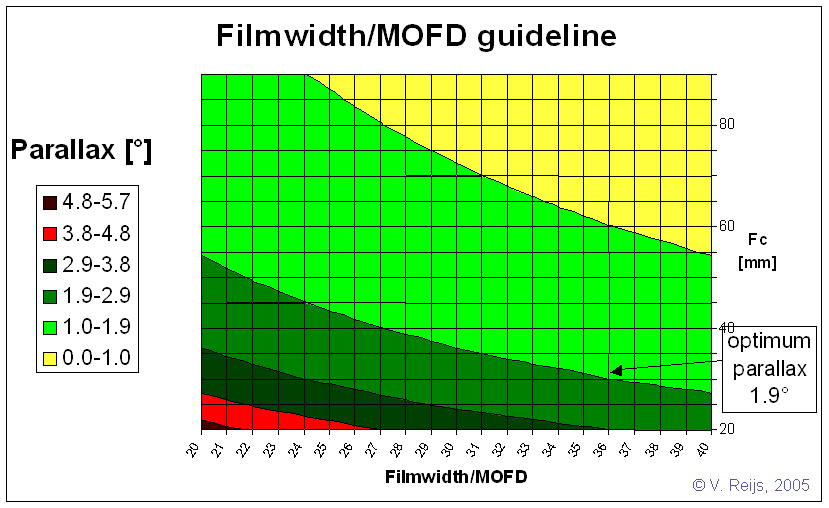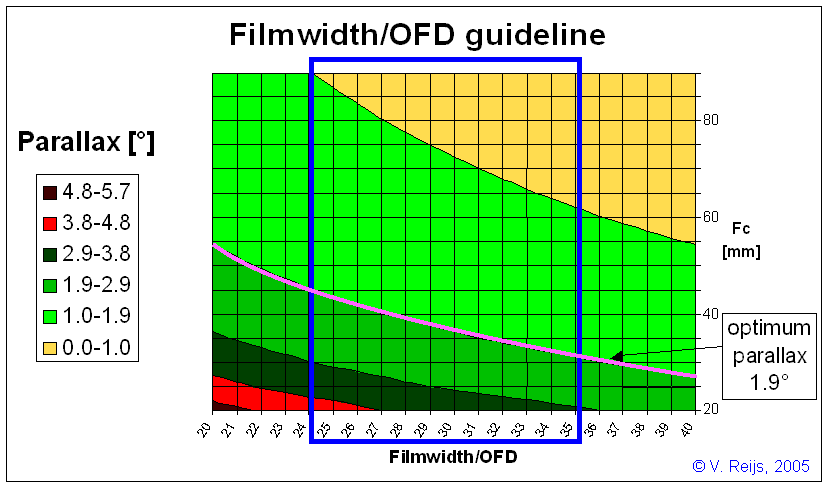NEW
| Term |
Definition/description |
| 3D image |
the image is the virtual 3D
scene that is seen when looking at a stereo pair, this is experienced
with
the brain.Several types are defined:
geometric, picture size, immersion Sometimes called: cyclopean image |
| 3D scene |
The actual scene in real live
(make up of physical objec ts) |
| a'c |
lens to film/chip distance [mm] (1/a'c=1/Fc-1/focusdistance) |
| nearestobjectact | distance nearest object in
actual scene [mm] |
| nearestobjectexp | distance nearest object in experienced image [mm] |
| farthestobjectact | distance farthest object in
actual scene [mm] |
| farthestobjectexp | distance farthest object in expereinced image [mm] |
| b0 |
stereo
base [mm] of camera |
| CoC |
Angular Circle
of
Confusion [°],
sometimes also in [mm] |
| con/divergence |
see vergence |
| deviation |
The 2D displacement [mm or
pixel] of
homologous points in the stereo pair, which is a result of a certain
depth in the 3D scene. This term is equivalent with OxD. The deviation is the difference between the 'homologous separation of the point under investigation' and the 'homologous separation of the farthest points'. (equivalent to Ferwerda [1990], page 236-237) Deviation can be in the horizontal of vertical direction (or a combination of the two, like a vector in a (2D) plane). (some people call this parallax [mm or pixel], which seems to be true in astronomy for instance and in technical paper it is also called disparity). |
| DH |
Hyperfocal distance, this is
closest distance that is perceived as sharp when the camera lens is
configured for infinity [mm]. (Hawkins [1980],
page 71) |
| eye separation |
The distance between the two
optical axis of the eyes [mm] (some people call this Inter Pupil Distance: IPD, Inter Ocular: IO) |
| filmwidth |
width of uncropped film/chip
[mm or pixel] |
| Fc | camera's focal length [mm] |
| FoV |
Field of View [°] is the
horizontal angular part visible in the actual (act) scene or
experienced (exp) image. |
| Fv |
stereo viewer's focal length [mm] |
| fixation distance |
equivalent to vergence distance, but fixation is
used for distance/angles related to the human eye. |
| focusdistance | The focused distance [m] Accomodation is also used for the focused distances of the eye. |
| HAOxD | Highest Allowable On x
Deviation [mm or pixel] (threshold deviation related to highest
comfortable
experienced parallax angle [~4°]). x can be film/chip (F), screen/display/picture (P), viewfinder (V), retina (R), etc |
| LAOxD |
Lowest Allowable On x
Deviation [mm or pixel] (threshold deviation related to parallax angle
which
still gives enough experienced stereoscopic depth [~1°]) x can be film/chip (F), screen/display/picture (P), viewfinder (V), retina (R), etc |
| M |
Magnification (a'c/focusdistance)
[m] |
| MAOxD |
Maximum
Allowable On x
Deviation [mm or pixel] (I think this is the same as my OOxD...) x can be film/chip (F), screen/display/picture (P), viewfinder (V), retina (R), etc |
| MOxD | Actual Maximum On x Deviation
[mm or pixel]
(due
to
nearestobjectact and farthestobjectact), same as
NetOxD x can be film/chip (F), screen/display/picture (P), viewfinder (V), retina (R), etc |
| NetOxD |
Netto
On x Deviation [mm or pixel].
This is the same as my MOxD. x can be film/chip (F), screen/display/picture (P), viewfinder (V), retina (R), etc When people talk about NetOFD they determine it by: NetOFD=deviationwinnear - deviationwinfar with: deviationwinnear: the deviation of to nearest object relative to the deviation of the stereo window [mm or pixel] deviationwinfar: the deviation of to farthest object relative to the deviation of the stereo window [mm or pixel] A deviationwin in front of stereo window is negative, while behind it it is positive. |
| nonstereooverlap |
non stereo overlap on
film/chip/screen
[mm or pixel] at the stereo window (is normally cropped away). |
| OxD |
The actual On x Deviation
[mm or pixel] (due
to a certain homologous distant point and farthestobjectact
point). Same as deviation x can be film/chip (F), screen/display/picture (P), viewfinder (V), retina (R), etc |
| OOxD | Optimum On x Deviation [mm or
pixel]
(related to an optimum experienced parallax angle [parallaxopt~1.9°]) x can be film/chip (F), screen/display/picture (S), viewfinder (V), retina (R), etc. |
| parallax |
parallax angle due to
different standpoints (like due to eye separation or stereo base) for
a certain point in a 3D scene [°] (Ferwerda [1990], page 237) Parallax can be an angle in the horizontal of vertical plane (or a combination of the two, thus like a vector in a 3D scene). Some people use the word parallax instead of deviation. |
| parallaxopt |
optimum parallax angle of 1.9
[°] for instance due to a 2 m nearest object, farthest object at
infinite and an eye separation
of 65.5 [mm] |
| picture |
is a 2D representation of the 3D scene. |
| Q |
a factor between filmwidth and
deviation [-] |
| homologous separation |
The distance between homologous
points in the two pictures of the stereo pair [mm or pixel]. |
| shifting |
Shifting the pictures of the
stereo pair in horizontal or vertical direction relative from each
other [mm or pixel] (the horizontal shifting changes the experienced
stereo depth of the stereo window). (some people call this parallax [mm or pixel], this is confusing, because the shifting has nothing to do with parallax [aka. different angles]) |
| stereo
base |
The distance between the two
object sof the camera [mm] (Some people call it Inter Axial: IA) |
| stereo depth |
The distance between nearest and
farthest object [mm] in actual life or experienced image |
| stereo pair |
consists of two pictures taken from different
viewpoint (distance between viewpoints is stereo base) |
| stereo window |
the (2D) plane of the 3D image
that
is experienced at the same depth as the display screen (display,
projector screen, paper, frame, etc.). At this plane there is normally
a 100%
stereo overlap for the objects that are at that particular
depth/distance. If the homologous separation of certain points is the same as the frame separation, the stereo window is at the frame plane. |
| vergence angle |
The angle between optical axis
of the two lenses/eyes. A vergence angle
of zero meas parallel axis, a positive vergence angle is convergence
and a negative vergenbce angle is divergence Some people use half it (so defined towards the parallel line) |
| vergence distance | The vergence distance tells
where the
optical axis of the two lens systems cross (under vergence angle). If
this distance is in front of the lens system we talk of convergences,
if behind it is divergence. |

Rule/guideline |
Condition |
|||||||||||
| farthestobjectact <=2*nearestobjectact |
farthestobjectact> 100*nearestobjectact |
deviation =Fc/30 |
deviation =a'c/30 |
deviation =1 |
deviation =1.2 |
b0/nearestobjectact= 1/30 |
25<= Filmwidth/MOFD <=35 |
Filmwidth/MOFD =30
|
Fc<< 2*nearestobjectact |
Fc =35 |
||
| Stereo base |
Bercovitz Case 1 |
|||||||||||
| Di Marzio1 |
X |
|||||||||||
| Di Marzio2 | X |
|||||||||||
| Di Marzio3 | X |
X |
||||||||||
| Sekitani |
X |
|||||||||||
| Herbig |
X |
X |
X |
|||||||||
| Reijs |
||||||||||||
| Deviation |
Ferwerda |
X |
X |
X |
||||||||
| Di Marzio4 |
X |
X |
||||||||||
| Di Marzio5 | X |
X |
X |
|||||||||
| Non stereo overlap |
DrT |
X |
X |
|||||||||
| Ferwerda |
X |
X |
X |
|||||||||
| Miscellaneous |
Lopp |
X |
X |
|||||||||
| ISU | X |
X |
||||||||||
| PKK |
X |
X |
X |
|||||||||
| Glickman | ||||||||||||

| Fc | b0/nearestobjectact |
| 35 |
1/30 |
| 50 |
1/40 |
| 74 |
1/64 |
| 135 |
1/116 |
